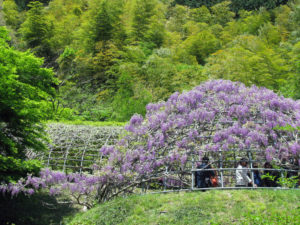LaLaport Fukuoka
The large-scale commercial complex “Mitsui Shopping Park LaLaport Fukuoka” has had its grand
opening on the former site of the Fukuoka City Fruit and Vegetable Market in Naka, Hakata Ward.
 |
 |
 |
January 22, 2025
Environment tour for Japanese citizen group
We have operated Environment tour in Kitakyushu-city and visited
Kitakyushu Ecotown Center and Kyushu Paper Company.
 |
 |
 |
January 21, 2025
Kawachi Wisteria Garden
Kawachi Wisteria Garden is a private garden at the Mountain foot of Sarakura, in Kitakyushu-city.
The garden is opened to the public seasonally during the wisteria season which usually peaks
around late April to middle of May. We are waiting your visit.
 |
 |
 |
January 20, 2025
Local shopping street
It known as ‘Shoutengai’ offers a mix of shopping, food and events. Each street has its own
mix of local stores and bigger brand names lined up on each side of a street which is often
shut off from heavy traffic. You can enjoy shopping to find local items duruing tour.
 |
 |
 |
January 19, 2025
Mojiko Retro, beautiful port
It is fine day today in Kitakyushu-city. Mojiko Retro is a tourist destination of beautiful port town
designated as a Japan’s special trading port in 1889.
There are many kind of unique designed building constructed which are harmonized with
European and Japanese culture. Shopping, eating of local specialties and sightseeing can
be enjoyed.
 |
 |
 |
January 18, 2025
Many tourists in Yufuin
Many tourists are travelling in Yufuin today from mainly Asian countries and Japan.
 |
 |
 |
January 17, 2025
Cherry blossom forecast in 2025
In Kyushu, they start blooming around March 22 and become full bloom around March 31.
You can enjoy beautiful cherry blossom in any places in Kyushu.
 |
 |
 |
January 16, 2025
One Piece Statues in Kumamoto-prefecture
The Great Kumamoto Earthquake occurred in 2016, causing extensive damage throughout
Kumamoto-prefecture. As part of the Kumamoto Reconstruction Project from Earthquake,
the statue of Luffy was erected in the Kumamoto Prefectural Government Promenade in
November 2018. This was realized with the cooperation of Eiichiro Oda, a native of
Kumamoto-city and the author of the popular manga “One Piece,” to support the reconstruction
of the areas affected by the Kumamoto Earthquake.
In November 2020, another 9 statues were erected at other places in Kumamoto-prefecture.
 |
 |
 |
January 15, 2025
Tosu Premium Outlets
The biggest outlet mall in Kyushu located in Tosu, Saga-prefecture.
There are 150 famous shops from in/outside of japan, including Golf shops as well.
 |
 |
 |
January 14, 2025
Hell tour in Beppu
The most enjoyable experience in Beppu is Jigoku Meguri or Hell tour. A collection of hot springs
where the water bubbles forth from underground, often with unusual result.
 |
 |
 |
January 13, 2025
